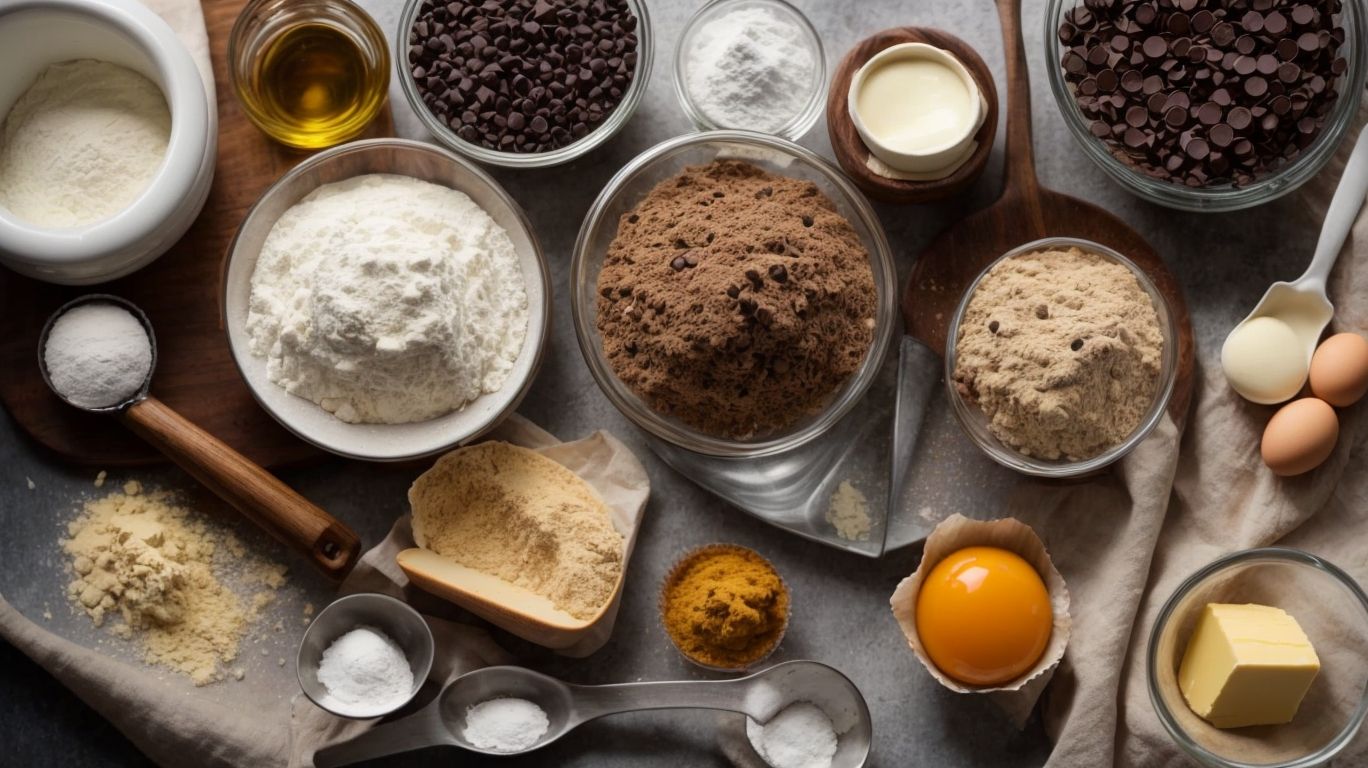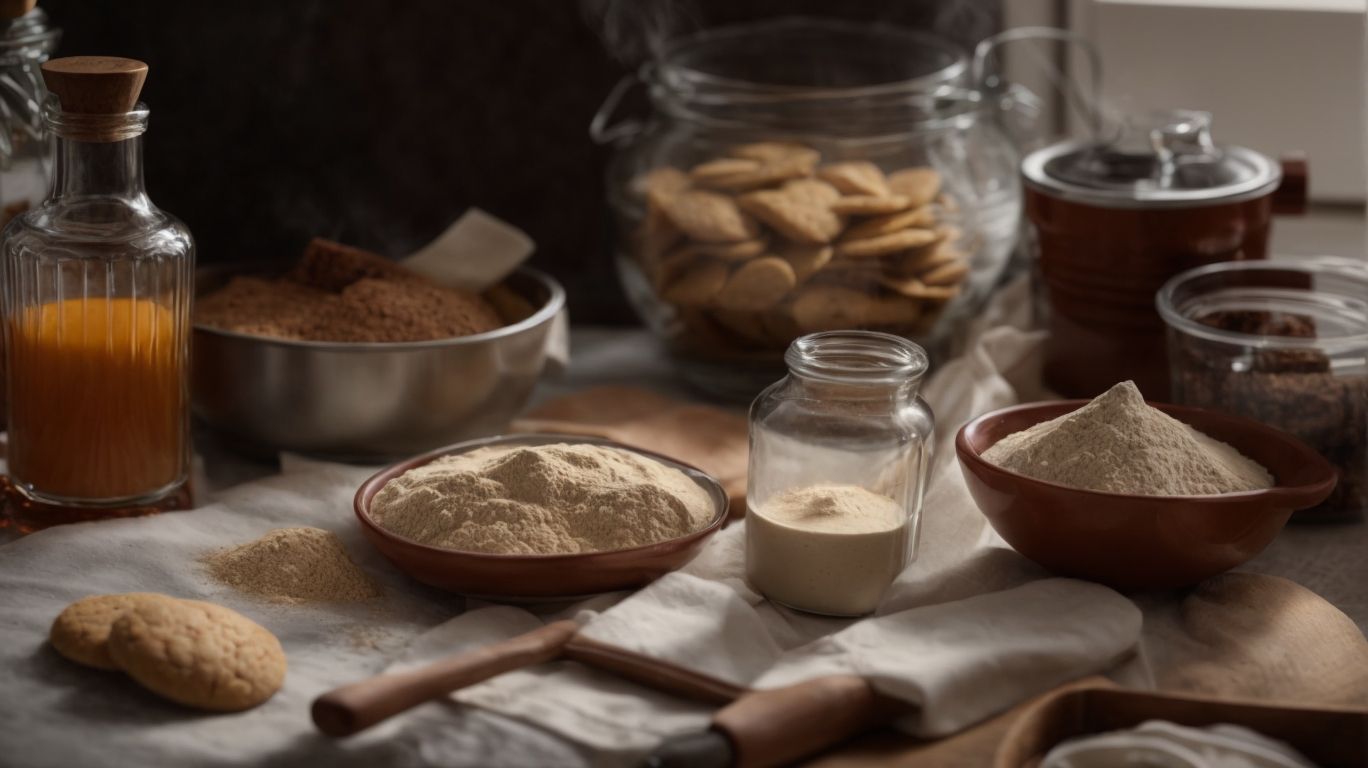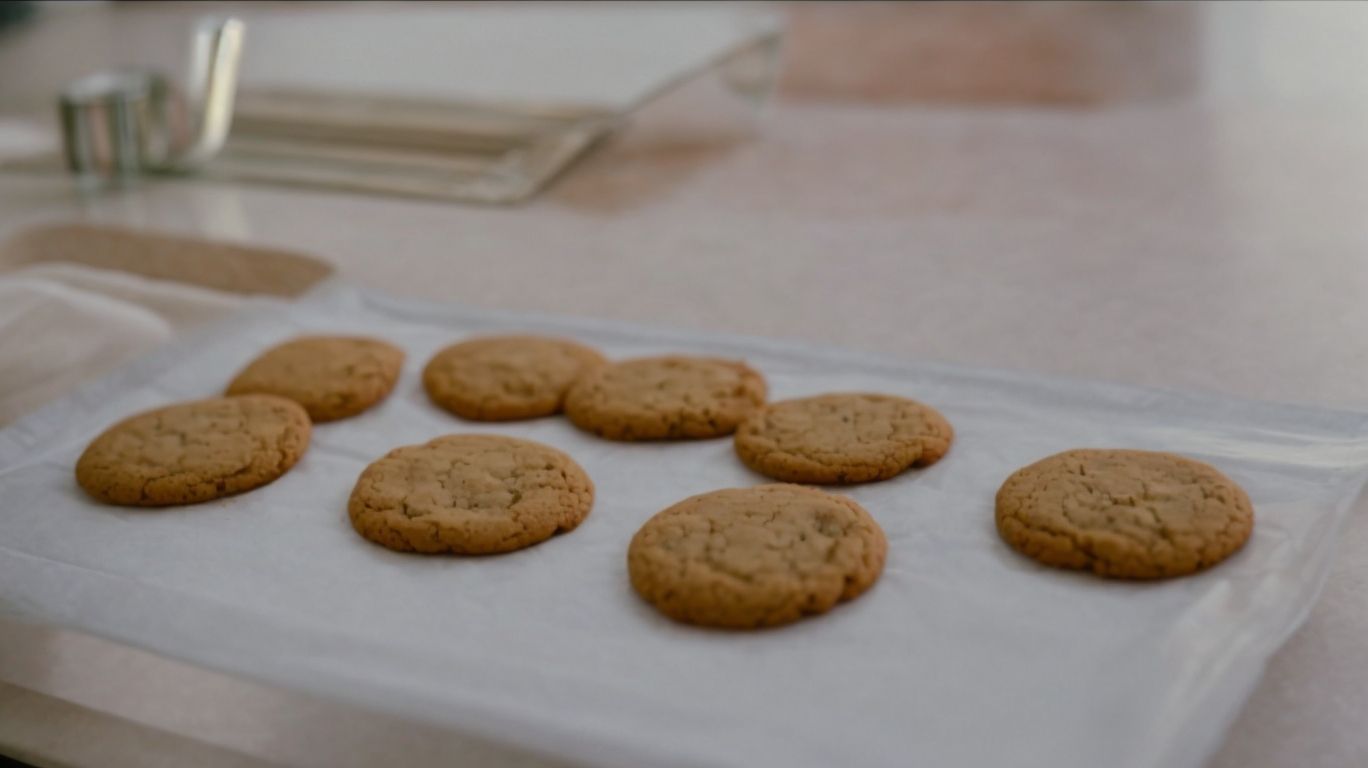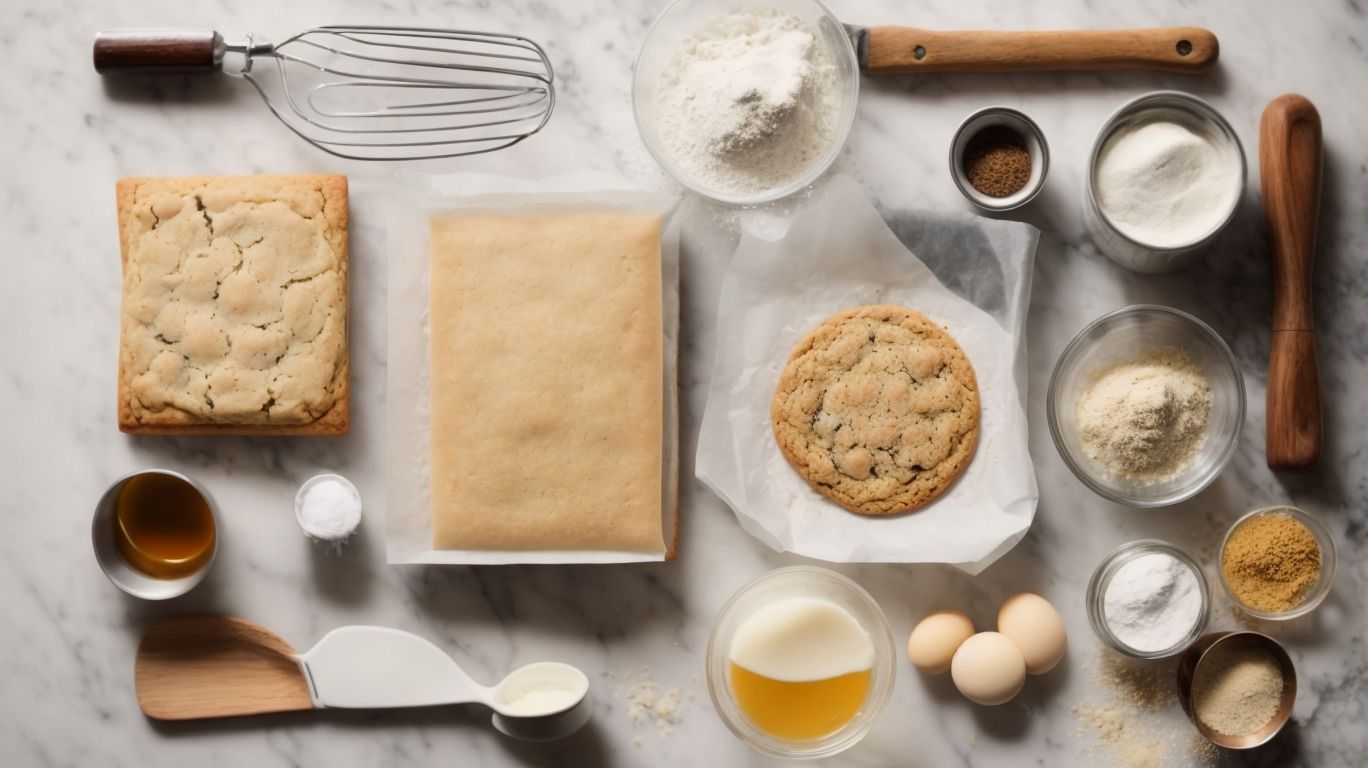How to Bake Cookies?
Craving a freshly baked batch of cookies? Look no further!
We explore the essential ingredients and equipment needed for baking delicious cookies. From the classic flour and sugar to the perfect mixing bowls and measuring cups, we’ve got you covered. Plus, we’ll walk you through the step-by-step process of creating the perfect cookie dough and share some expert tips for achieving perfectly baked cookies every time.
Get ready to satisfy your sweet tooth and impress your friends and family with your baking skills!
Key Takeaways:
What are the Ingredients Required for Baking Cookies?

Credits: Poormet.Com – Jeremy Anderson
To bake delicious cookies, you will need a combination of key ingredients that include flour, sugar, butter, eggs, baking powder/soda, and flavorings like vanilla extract or chocolate chips.
Flour serves as the foundation of the cookie, providing structure and body to the dough. The type of flour used, such as all-purpose, whole wheat, or gluten-free alternatives, can alter the texture and taste of the final product. Sugar not only sweetens the cookies but also helps with browning and texture. Different sugars like granulated, brown, or powdered sugar can be experimented with for unique outcomes.
Butter adds richness and flavor, contributing to the cookie’s tenderness and moisture. Eggs act as a binding agent, holding the ingredients together and providing structure. They also help with leavening, creating a softer texture.
Flour
Flour is a fundamental ingredient in baking cookies, providing structure and texture to the dough.
Regarding selecting the right type of flour for your cookies, you have a few options to consider. All-purpose flour is a versatile choice that strikes a balance between protein content and gluten development, resulting in cookies with a tender crumb and slightly chewy texture.
On the other hand, using whole wheat flour can add a nutty flavor and a denser texture to your cookies, making them heartier and more substantial. If you’re looking for a gluten-free alternative, opt for almond flour, coconut flour, or a gluten-free all-purpose blend to achieve similar results without compromising taste or texture.
Sugar
Sugar adds sweetness and helps in caramelization, giving cookies their golden brown color and crispy edges.
While granulated sugar provides the structure and stability to the cookie dough, brown sugar contributes moisture and chewiness. By adjusting the amount of sugar in a cookie recipe, you can alter its texture dramatically. Decreasing sugar can result in a crisper, more brittle cookie, while increasing it yields a softer, chewier texture. The type of sugar used can impact the flavor profile – brown sugar adds hints of caramel and molasses notes, whereas granulated sugar offers a straightforward sweetness.
Butter
Butter is a key ingredient that provides richness, flavor, and helps cookies spread during baking.
One important factor to consider when using butter in cookie recipes is its temperature – using softened butter is crucial for creaming with sugar. Softened butter blends smoothly with sugar, creating a light and airy texture that leads to perfectly soft and chewy cookies. This creaming process incorporates air into the dough, resulting in a light and tender crumb.
Regarding the texture of cookies, butter plays a significant role. It helps to create a tender and moist cookie, while also contributing to the rich flavor that we all love. The right amount of butter can help the cookies hold their shape while baking, and promotes a golden-brown crust.
For those looking for alternatives to butter, margarine or oils can be used in cookie recipes. It’s important to note that these substitutes can alter the texture and flavor of the cookies. Margarine may result in cookies that spread more and have a slightly different taste, while oil can make cookies denser and less flavorful. Experimenting with different fats can lead to unique variations in cookie consistency and taste.
Eggs
Eggs act as a binding agent in cookie dough, providing structure and moisture to the final baked product.
Regarding the use of eggs in cookie recipes, both whole eggs and egg yolks play crucial roles. Whole eggs contribute not only to the binding aspect but also provide moisture and help with leavening due to the proteins and fats present in the yolk and whites. On the other hand, using just egg yolks can result in cookies that are richer and more tender, due to the higher fat content in the yolks.
For those looking for egg substitutes, there are various options available for vegan or allergy-friendly baking. Plant-based alternatives such as applesauce, mashed bananas, or flaxseed mixed with water can work as effective replacements for egg yolks, maintaining the binding properties in the cookie dough while adapting to dietary preferences and restrictions.
Baking Powder/Soda
Baking powder or baking soda helps cookies rise and expand during baking, resulting in a soft and fluffy texture.
It’s essential to understand the distinction between these two leavening agents.
- Baking soda requires an acid and a liquid to activate its leavening properties.
- Baking powder contains its own acid, usually cream of tartar, and only needs a liquid to start the chemical reaction.
Baking soda is often used in cookie recipes with acidic ingredients like chocolate or buttermilk, while baking powder is preferred in cases where there are no acidic components.
Proper measurement of these leavening agents is crucial; using too much can result in a chemical taste, while too little may lead to flat cookies with a dense texture.
Flavorings (Vanilla extract, chocolate chips, etc.)
Flavorings like vanilla extract and chocolate chips enhance the taste and aroma of cookies, adding a delicious twist to the classic treat.
Regarding flavoring cookie dough, the possibilities are endless.
- Extracts such as almond, mint, or lemon can infuse unique flavors into your cookies, making each bite a delightful surprise.
- Spices like cinnamon, nutmeg, or ginger can add warmth and complexity to the dough, creating a comforting and aromatic sensation.
For those who love a bit of texture in their cookies, incorporating mix-ins such as nuts, dried fruits, or shredded coconut can elevate the overall taste profile. High-quality ingredients are paramount in achieving superior flavor and texture in your cookies, ensuring a delectable outcome that will have everyone coming back for more.
What Equipment Do You Need for Baking Cookies?

Credits: Poormet.Com – Andrew Lopez
Plus ingredients, having the right equipment is essential for baking perfect cookies.
Among the essential tools for baking cookies are mixing bowls, which come in various sizes and materials such as stainless steel, glass, or ceramic. They are necessary for combining ingredients and mixing the dough. Measuring cups are crucial to ensure accurate quantities of ingredients are added. Baking sheets are used to place the cookie dough for baking. Parchment paper is ideal for lining baking sheets, preventing cookies from sticking. Optional items like electric mixers can make the mixing process quicker and more efficient.
Mixing Bowls
Mixing bowls are used to combine ingredients and create cookie dough with the right consistency.
It is important to have a variety of bowl sizes when baking to accommodate different recipe quantities. Small bowls are ideal for whisking together spices or beating eggs, while large mixing bowls are perfect for mixing cake batters or dough. The material of the bowl can also affect the baking outcome – glass or stainless steel mixing bowls are preferred as they do not retain odors or affect the taste of the ingredients. Temperature plays a crucial role in baking, so using room temperature ingredients and bowls can help ensure even mixing and consistent results.
Measuring Cups and Spoons
Accurate measurements are key in baking, and using measuring cups and spoons ensures precise ingredient quantities.
Regarding measuring ingredients correctly in cookie recipes, the type of measuring tools used can make a significant difference in the final outcome of your baked goods. Dry measuring cups are designed to be filled to the top with ingredients like flour, sugar, and oats, allowing you to level them off easily for accuracy. On the other hand, liquid measuring cups usually have a spout for pouring and are best suited for liquids such as milk, oil, and water.
For smaller quantities of ingredients like baking powder, salt, or vanilla extract, measuring spoons come in handy. It’s important to note that measuring spoons are not the same as regular teaspoons and tablespoons from your silverware drawer, as they are specifically designed for precise measurements.
Brands like OXO, Cuisipro, and KitchenAid are known for their durable and accurate measuring tools, ensuring that you can rely on consistent results every time you bake. Investing in high-quality measuring cups and spoons made of stainless steel or durable plastic can go a long way in improving the accuracy of your measurements and the quality of your cookies.
Baking Sheets
Baking sheets are essential for baking cookies, providing a flat surface for even heat distribution and browning.
Regarding choosing the right baking sheet for your cookies, there are a few options to consider. Rimmed baking sheets, also known as sheet pans, have raised edges that prevent juices and oils from spilling over, which can be beneficial for certain types of cookies. On the other hand, non-stick baking sheets are convenient for easy release of cookies and hassle-free cleanup.
- Each type of baking sheet can have a different impact on your cookie texture. Rimmed baking sheets may result in chewier cookies with slightly undercooked centers, while non-stick sheets often yield crispier edges.
Parchment Paper
Parchment paper is often used to line baking sheets, preventing cookies from sticking and ensuring easy cleanup.
One of the key benefits of utilizing parchment paper in baking is that it greatly reduces the need for greasing pans, making for a healthier cooking process overall. The natural non-stick properties of parchment paper prevent food items from clinging to the baking surface, resulting in beautifully baked goods without any residue left behind.
Regarding removing freshly baked cookies, parchment paper makes this task effortless, ensuring that delicate treats maintain their perfect shape. This not only saves time but also promotes consistent baking results with each batch.
Electric Mixer (optional)
An electric mixer can make the mixing process faster and more efficient, especially when creaming butter and sugar for cookie dough.
Aside from saving time, using an electric mixer offers additional benefits in baking. One major advantage is the ability to achieve a consistent texture and structure in your batters and doughs, which is crucial for obtaining perfect results every time.
The powerful motor and various attachments of an electric mixer allow for thorough mixing, ensuring even distribution of ingredients without overmixing or undermixing. This can lead to better rise, crumb, and overall taste and texture of your baked goods.
Steps for Baking Cookies

Credits: Poormet.Com – Willie Smith
Following a precise set of steps is crucial for baking perfect cookies every time.
Start by preheating your oven to the temperature specified in your recipe. This ensures that the cookies will bake evenly and achieve the desired texture.
While the oven is preheating, combine the dry ingredients – typically flour, baking powder, and salt – in a bowl and whisk them together to ensure even distribution.
In a separate bowl, cream together softened butter and granulated sugar until light and fluffy, creating a smooth base for the cookie dough. Then, add in the eggs one at a time, along with vanilla extract or other flavorings.
Preheat the Oven
Preheating the oven to the correct temperature ensures that cookies bake evenly and consistently.
When the oven is properly preheated, it allows the cookie dough to set quickly upon entering, creating the ideal environment for that perfect cookie texture – crispy on the edges and soft in the center. This initial burst of heat helps rapidly set the structure of the cookies, preventing excessive spreading and resulting in a beautiful shape. Baking at common temperatures like 350°F (180°C) or 375°F (190°C) ensures that the cookies bake to perfection, with a golden-brown hue and a delicious aroma that fills your kitchen.
Combine Dry Ingredients
Combining dry ingredients like flour, baking soda, and salt ensures even distribution and consistent flavor in cookie dough.
Incorporating specialized dry ingredients such as cocoa powder, ground spices, or instant coffee can elevate the flavor profile of your cookies.
To begin, sifting the dry ingredients prevents clumps and aerates the mixture, resulting in a lighter texture.
Next, whisking or blending the dry ingredients thoroughly ensures that the leavening agents like baking soda are evenly distributed, promoting proper rise during baking.
These techniques are essential in achieving the desired chewiness or crispiness in your final cookies.
Cream Butter and Sugar
Creaming butter and sugar together creates a light and fluffy base for cookie dough, promoting a tender texture.
This process involves beating softened butter and sugar together until the mixture becomes pale and incorporates air, which aids in the leavening of the cookies. Achieving the right consistency is crucial; the mixture should be smooth, not grainy, and hold peaks when lifted with a spatula.
Properly creamed butter and sugar contribute to the structure of the cookies by trapping air bubbles that expand during baking, resulting in a soft and chewy texture. Depending on the type of cookie, variations in creaming technique may be required, such as longer creaming times for shortbread cookies to achieve a crumbly texture.
Add Eggs and Flavorings
Adding eggs and flavorings like vanilla extract or spices enriches cookie dough with moisture and taste.
When incorporating eggs, they not only act as a binding agent but also contribute to the structure and tenderness of the cookies. The proteins in eggs help hold the dough together while the fats add richness. Meanwhile, flavorings such as vanilla extract introduce a fragrant aroma that enhances the overall taste profile. Spices like cinnamon or nutmeg can add warmth and depth to the flavor, creating a more complex sensory experience.
For those looking to explore alternative options for flavor enhancements, consider using citrus zest for a bright, refreshing twist or extracts like almond or mint for a unique flavor profile. Experimenting with mix-ins such as chopped nuts, chocolate chips, or dried fruits can add texture and additional layers of flavor to your cookies.
Mix in Dry Ingredients
Gradually mixing in dry ingredients ensures thorough incorporation and uniform cookie dough consistency.
Proper incorporation of dry ingredients is crucial to achieve the perfect balance of flavors and textures in your cookies.
Gently folding in flour, baking soda, or cocoa powder can prevent overmixing, which often leads to tough and dense cookies.
To avoid this, use a rubber spatula or wooden spoon to gradually add the dry ingredients to the wet mixture. The goal is to mix just until the ingredients are combined; any further mixing can result in a less tender final product. Maintaining a light hand when blending ensures a delicate, melt-in-your-mouth texture in the finished cookies.
Scoop and Bake the Cookies
Scooping cookie dough onto prepared baking sheets and baking at the correct temperature yields perfectly baked cookies.
Using a cookie scoop helps ensure uniform cookie size, promoting even baking. When placing cookie dough on the baking sheet, space them about 2 inches apart to allow for spread. For chewy cookies, decrease baking time slightly and cool on the baking sheet for a few minutes before transferring to a wire rack. Conversely, for crispier cookies, extend the baking time and cool them directly on a wire rack. Consider investing in a silicone baking mat to prevent sticking and aid in easy cleanup.
Tips for Perfectly Baked Cookies
Achieving perfection in cookies requires attention to detail and following some essential tips for the best results.
One crucial aspect of baking flawless cookies is the temperature of your ingredients; make sure they are at room temperature to ensure proper mixing and texture. Another useful tip is to chill the cookie dough before baking—it helps prevent them from spreading too thin and maintains their shape during baking. Using parchment paper on your baking sheets not only ensures easy cleanup but also prevents the cookies from sticking. Remember to rotate your baking sheets halfway through the baking process to achieve even browning on all sides. Don’t forget to cool your cookies properly on a wire rack for the ideal texture and flavor.
Use Room Temperature Ingredients
Allowing ingredients like butter and eggs to come to room temperature before baking ensures proper mixing and consistent results.
When ingredients are too cold or too warm, it can significantly impact the texture of the cookie dough. Butter at room temperature blends smoothly with sugars, creating a light and airy texture. Eggs at room temperature incorporate evenly, resulting in a more uniform structure. Mixing ingredients at the right temperature also ensures that the flavors meld together perfectly for a delicious finished product.
To achieve the ideal temperature, set butter out on the counter for about 30 minutes, depending on the recipe. Eggs can be quickly brought to room temperature by placing them in a bowl of warm water for a few minutes. By allowing all ingredients to reach room temperature, you’ll set yourself up for baking success.
Chill the Dough
Chilling cookie dough before baking helps solidify fats, prevent spreading, and enhance flavor development.
One of the key benefits of chilling cookie dough is that it allows the fats in the dough, typically butter, to solidify. This process is crucial as it helps to reduce the spread of the cookies during baking, resulting in a thicker and chewier texture rather than thin and crispy. When the dough is left to chill, the flavors have more time to meld together, intensifying the overall taste of the cookies.
Depending on the recipe, different chilling times are recommended. For example, for soft and chewy cookies, it is advisable to chill the dough for at least 30 minutes up to 24 hours. On the other hand, for cut-out cookies that need to hold their shape, a longer chilling period of 2-3 hours or even overnight may be required.
Regarding texture and taste, chilling the dough also impacts the final result significantly. The cold dough takes longer to melt in the oven, which helps cookies maintain their shape during baking. This slower melting process leads to cookies that are thicker with a more tender and chewy interior.
If you are short on time but still want the benefits of chilled dough, there are some alternative methods to speed up the chilling process. Placing the dough in the freezer for a shorter period, using pre-chilled baking sheets, or even shaping the dough into individual cookie balls before chilling can help expedite the solidification of fats and achieve similar results.
Use Parchment Paper
Lining baking sheets with parchment paper not only prevents cookies from sticking but also makes cleanup a breeze.
Using parchment paper offers several advantages in cookie baking. It creates a non-stick surface, allowing cookies to easily release without breaking or leaving residue. This promotes even browning and prevents burnt bottoms. Parchment paper acts as a protective barrier between the cookies and the baking sheet, reducing the risk of overbaking or uneven cooking. Cleanup is simplified as parchment paper can simply be discarded after use, saving time and effort. Its versatility extends to other baking tasks beyond cookies, making it a valuable kitchen staple.
Rotate the Baking Sheets
Rotating baking sheets during the baking process promotes even heat distribution and prevents cookie burning or uneven browning.
By consistently rotating the baking sheets, you ensure that each cookie receives uniform exposure to the heat source, reducing the risk of some cookies becoming overly crispy while others remain undercooked. For thin and delicate cookies like lace cookies or tuiles, it is advisable to rotate the sheets halfway through the baking time to prevent them from getting too brown around the edges. For thicker cookies such as chocolate chip or oatmeal, rotating the sheets a quarter turn after the first half of baking can help achieve a perfectly golden-brown color and a soft, chewy texture throughout.
Cool the Cookies Properly
Allowing cookies to cool properly on a wire rack after baking ensures they set and achieve the desired texture.
When cookies come out of the oven, they are still undergoing a final phase of baking from the residual heat. Placing them on a wire rack immediately helps speed up this process by allowing air to circulate around the cookies evenly.
This rapid cooling helps the cookies develop that perfect balance between crispy edges and a chewy center. The airflow prevents the cookies from becoming soggy underneath due to trapped steam, ensuring a consistent texture throughout.
Depending on the type of cookies you’re baking, the cooling time and method can vary. For delicate cookies like lace cookies or meringues, allowing them to cool completely on the rack is crucial to maintain their delicate structure.
Frequently Asked Questions
1. How do I bake cookies that come out perfectly every time?
To bake perfect cookies, make sure to follow the recipe precisely and avoid making substitutions. Also, make sure to preheat your oven to the correct temperature and use an oven thermometer to ensure accuracy.
2. Can I use salted butter instead of unsalted butter in my cookie recipe?
It is best to use unsalted butter in baking as it allows you to control the amount of salt in your recipe. If you only have salted butter, reduce the amount of added salt in your recipe to compensate.
3. How can I make my cookies chewier?
To achieve a chewy texture in your cookies, use a higher ratio of brown sugar to white sugar in your recipe. Brown sugar contains more moisture which helps create a chewy texture.
4. Can I use a different type of flour in my cookie recipe?
Depending on the type of cookie, you may be able to use a different type of flour, such as gluten-free or almond flour. However, keep in mind that different flours may alter the texture and flavor of your cookies.
5. How do I prevent my cookies from spreading too much while baking?
To prevent cookies from spreading too much, make sure your butter is at room temperature and not too soft. Also, try chilling the dough for 30 minutes before baking, as well as using a higher ratio of flour to butter in your recipe.
6. Can I freeze cookie dough before baking?
Yes, you can freeze cookie dough before baking. Simply shape the dough into balls and place on a baking sheet lined with parchment paper. Freeze for 1-2 hours, then transfer the dough balls to a freezer-safe container. When ready to bake, let the dough thaw in the fridge for a few hours before baking.

